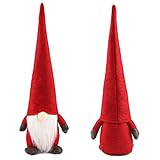Nisse – A Norwegian Santa

Nisse – A Norwegian Santa


If you spend time in Norway during Christmas you’ll be sure to see tons of nisser (nisse dolls) around. The Nisse is part of the old Nordic folklore, and is a supernatural being. But what specifically is a nisse? Is it a gnome, an elf, or perhaps a Norwegian Santa? Let’s find out.
A short description of the Nisse
The Nisse is a short grown being with an old man’s face and a grey or white beard. Usually he wears a red hat, wooden shoes and a wadmal jacket and pants (wadmal is a coarse, dense, usually undyed wool fabric).
The Nisse usually lived out in the stable or on the barn, but he could also live up in the mountains or in old trees out in the forest. It’s hard to get a glimpse of the Nisse since he usually makes himself invisible. But even though he is rarely seen, he is never far away and is always paying close attention to what is going on.
A Nisse can have a bit of a temper. They are not dangerous, but definitely a bit angry and very determined. They can be quite mischievous, so in the old folk belief it was considered important to be on good terms with them. Usually the Nisse is a man (nissefar), but there are also tales about his wife (nissemor) and his children (nissebarn).
Looking to buy a little nisse? You can find some nice ones here at Etsy or Amazon.

Etymology – Nisse
There are some different theories to why we call this being for a Nisse. In Denmark, Nisse or Nis is a nickname for the names Niels or Nils, which again stems from the worship of Saint Nicholas (Nikolas) during the medieval ages. According to the folklore, each farm had a Vette (a supernatural being) also known as a Gardvord, who was constantly watching what was going on. In Denmark they named the Gardvord Nis, so most likely the word Nis came to Norway from Denmark, and then transformed into Nisse. In Sweden the Nisse is often also refered to as a “Tomte”.
The History of the Nisse
Most likely the origin of the Nisse goes back to heathen times in Scandinavia. The Gardvord, which I mentioned above, was considered to be the first “farmer” on the farm. If you treated the Gardvord well he would bring prosperity to the people on the farm, and a way to please him was to make small sacrifices. Typically this would be putting out beer and food during the holidays, and especially during Jul (Christmas). The tradition today is to put out a bowl of rice porridge on Christmas Eve.

Despite Christianity coming to Norway in the 11th century, the belief in the Gardvord continued, and he ended up in the folklore together with other creatures such as troll, draug and hulder. In the old folktales he would be described as the little man who took care of the animals and protected the humans on the farm agains evil forces.
After the reformation in 1537, Protestant priests saw the Nisse as a supernatural being, and therefor as a false belief and a compliance of Catholicism and Paganism. The Nisse was demonised, and seen as evil and a representative of the devil. As a result of this, during the 16-1700s a lot of the old folk belief died out in Norway. But, with the national romantic era and a renewed popularity of the old folk tales in the 1800s, many of the old tales of the Nisse were collected and written down, and once again became something that people cared about.
A Nisse used to be a quite complex creature, with many functions, names and abilities. However, at the end of the 1800s and during the 1900s, the story of the Nisse and how he was presented in literature was simplified, and he was turned into a stereotype better suited for the society of those days (and of present day society).
Julenissen – The Christmas Nisse
Many countries in Europe created their “Santa” with inspiration from Saint Nicholas. In Scandinavia however, Santa was inspired from our Nisse. This was probably because it was especially important to be good with the Nisse during Jul. It became a tradition in Norway in the early 1900s that every Jul (Christmas), the Julenisse or Fjøsnisse (fjøs = a barn) would come the evening before Julaften (Christmas eve), and put a gift in a sock hanging over the bed, or in a shoe that would be worn the next day.

Nisser on a Christmas card

Nisse family
Starting in the mid 1800s, it was also a tradition to include the Nisse in Christmas cards and in other Christmas illustrations. The first Norwegian Julenissekort (Nisse Christmas card) was made in 1883 by Wilhelm Larsen. By then the Nisse is made into a more harmless figure than he was in the folklore.
Looking to buy a little nisse? You can find some nice ones here at Etsy or Amazon.
The Nisse during the World War 2
Norway was occupied by Nazi Germany from 1940-45. During these years the Nisse became a symbol of a resistance. After all, he was considered to be something genuinly Norwegian. In 1941 a series of Christmas cards were published, showing a Nisse wishing God Jul (Merry Christmas) to all Norwegians. It did not take long before the Nazis discovered the significance of the Nisse, and on the 22nd of December that same year they prohibited these kind of Christmas cards.
The red Nisselue (Nisse hat) also became a symbol for the resistance, and on the 26th of February 1942, it was not allowed to wear a red hat in Norway…

You might also like: Christmas Sheaf – A Norwegian Tradition
The Nisse in Norway today
The significance of the Nisse is constantly evolving. Quite often the Nisse is a mix of the Julenisse and the American Santa Claus, and it can sometimes be hard to know the difference.
A typical tradition in Norway has been to put out a bowl of rice porridge for the Nisse on Christmas eve. This was something we did when I grew up, and then later in the evening we would check on the bowl, and it would be empty. The Nisse (or my dad) had eaten it all up!
Today a whole nisse-universe exists, with rampenisser (naughty nisser) which are tiny nisser that lives inside the house. Blånisser (blue nisser), which lives up in the mountains and can only go out during the “blue hour” (the hour each dawn and dusk when the sun dips below the horizon and the sky turns deep).
We can be sure that many more kinds of Nisse will be invented in the future, but hopefully still with some root in what the original Nisse once was.
Thanks for reading!
Your friend in Norway,
Pål
DISCLAIMER: Products on this page may contain affiliate links, and I might make a small sum per purchase. For you this does not affect the product price, but supports me and my work, and makes me able to continue sharing my passion for Norway with you. Read the Disclaimer policy. Thank you, tusen takk!
5 Comments
Leave a Comment
Join the Newsletter

Get my digital recipe book with seven traditional and tasty Norwegian delights!
Join on Patreon

Become a part of the virtual viking Norway With Pål family, support, and get exclusive content and perks!
Looking for something?
Donate on Paypal

Your support helps me to continue sharing my passion for Norway with you.
Tusen takk! Thank you!







That was fascinating!!! Thanks so much for sharing that. It’s interesting the similarities with some of our Canadian traditions and also English traditions and the Norwegian traditions but not surprising as many Norwegians emigrated to Canada as did other Scandinavians. Of course people often add to these traditions with their own creativity. When our son was little long after he had gone to bed on Christmas Eve, I would put the presents out under the tree and then sprinkle fine glitter from the fireplace to the tree and to a chair. In the morning I pointed it out to our little son and said "Oh look! It’s Santa’s magic dust!!". I think that made it all the more special. One year, when celebrating Christmas with our young grandchildren I produced a small clump of Oak Moss Lichen sprinkled with fine glitter and told the grandchildren that it was special lichen for the reindeer. They needed to eat it to help them fly. I love the magic of Christmas.
Yes, probably many of these "beings" stem from similar stories and beliefs around the world. It’s fascinating to learn how they have evolved differently from one country to another. If you start looking you’ll find that most countries got many similar beings to the Nisse.
I love the sprinkling of glitter!
Thank you for this interesting part of our history. The Julenissen has been a part of Christmas as far back as I can remember. No one knew the history behind it, just that it was as important for him to be part of the celebration as Santa was.
You welcome! It’s an important history to tell I think. As you say, he is an important part of our Christmas/Jul celebration!
The article on “What is a Nisse?” on Norway with Pal’s travel blog is a delightful exploration of Norwegian Christmas traditions. It offers an enchanting glimpse into the folklore surrounding these mischievous yet endearing creatures.